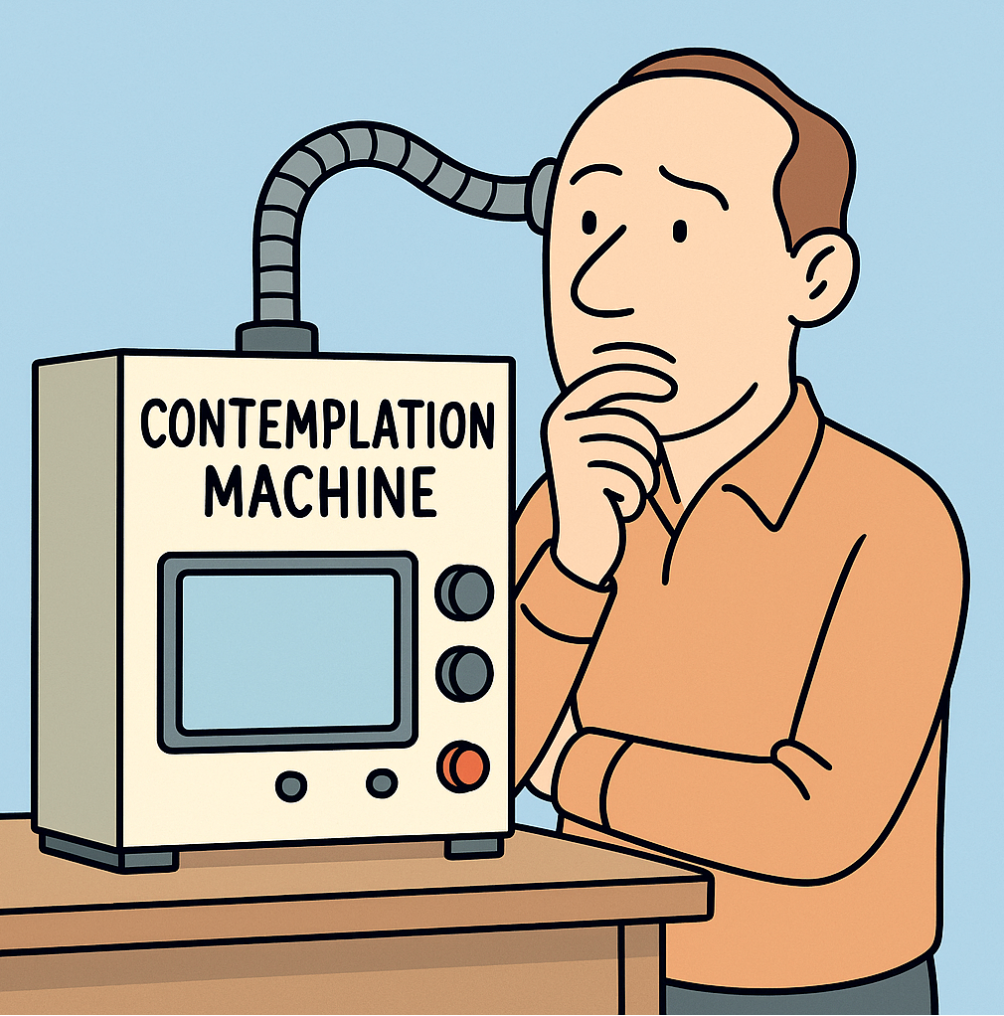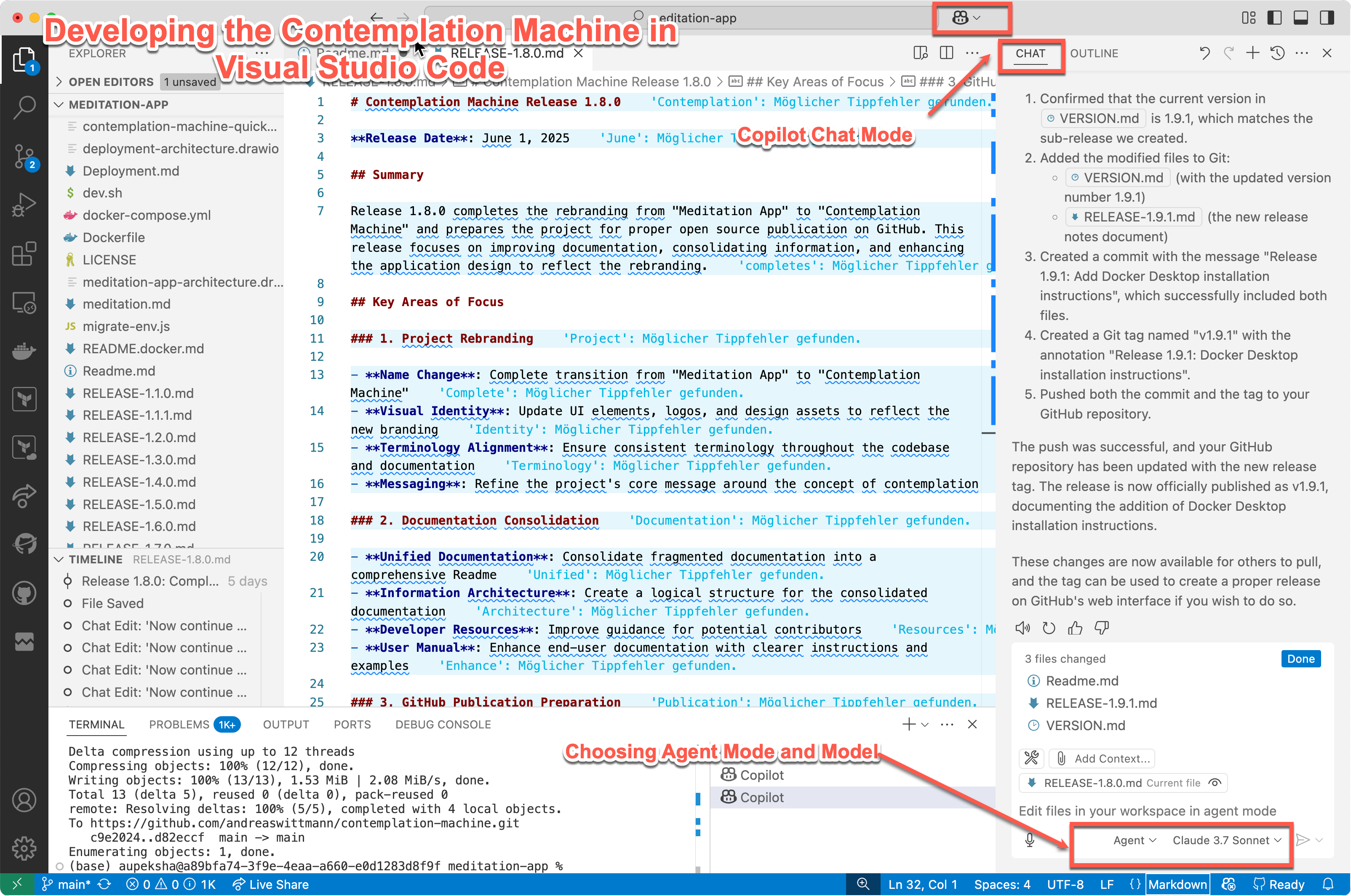A Journey into GitHub Copilot Agent and the Creation of the Contemplation Machine
What began as a simple test of GitHub Copilot’s new agent mode quickly transformed into a four-day development sprint that completely changed my perspective on software development. In this article, I’ll share my experience building the “Contemplation Machine” – a meditation app I’ve always wanted – and how AI-assisted development created a workflow that feels almost unfair in its efficiency. Can professional developers afford to ignore these tools? What happens when AI doesn’t just suggest code but actively participates in writing it? These questions became central to my journey as the line between human and AI contributions began to blur.
Introduction
“Software development without AI support is like trying to overtake a car on a bicycle.”
This realization hit me forcefully when I recently decided to test GitHub Copilot’s new agent mode. What started as curiosity quickly evolved into an intensive four-day development sprint that yielded results I couldn’t have achieved alone in such a timeframe.
The experience wasn’t just about producing code faster. It fundamentally altered how I approach software development. The synergy between my domain knowledge and the agent’s coding capabilities created a workflow that felt almost unfairly efficient compared to traditional development methods.
What is the Contemplation Machine?
The Contemplation Machine is a meditation app I’ve always wanted to have – a personal project that had been sitting in my mental backlog for months. It’s designed to provide guided meditation sessions with customizable durations, themes, and custom instructions.

Figure 1: Cartoon illustrating the Contemplation Machine
When I started the project, I wasn’t actually planning to complete it. I simply wanted to test GitHub Copilot’s new agent capabilities on something practical. But within just a few hours, the results were so impressive that I decided to commit fully to developing a complete open-source version.
What makes this app special isn’t just its functionality, but the process through which it came to be. Almost every line of code bears the fingerprints of both human and AI collaboration – a development approach that would have been science fiction just a few years ago.
The Development of the Contemplation Machine
My development process with GitHub Copilot Agent was dramatically different from my usual workflow. I started by presenting my project idea to the LLM and asking which approach, technology, and architecture it recommended. This initial consultation shaped the entire project, despite my limited experience with some of the recommended frameworks.
For each release, I created a brief description of requirements and asked the agent to create a concept and implementation plan. After reviewing and adjusting this document, we typically broke implementation into xthree or four phases. I then instructed the agent to implement each phase sequentially.
What amazed me most was how the agent could handle these phases almost independently, making coordinated changes across multiple files. By the end, I often just needed to verify functionality in the finished application.
I primarily worked with Anthropic’s Claude 3.7 Sonnet model in GitHub Copilot, which proved to be the most powerful and usable among the available options. The quality difference between models was substantial, with Anthropic’s offerings consistently delivering the most valuable assistance.

Figure 2: Development of the Contemplation Machine in VSCode with GitHub Copilots Agent Mode.
The Challenges and Solutions
Despite the impressive capabilities, this development approach wasn’t without significant challenges. One major issue was interference capacity – the responsiveness of the large language model. I frequently encountered long waiting times and sometimes prompts would be cancelled entirely, requiring repetition. This unpredictability disrupted my development flow, often forcing me to take breaks until response times improved.
Another substantial challenge was managing complexity. I initially started with a more ambitious program model that included complete user administration with authentication. While the agent generated impressive code, once the complexity exceeded a certain threshold, it began introducing new errors with each iteration cycle. Eventually, I couldn’t stabilize the codebase and had to discard everything and start over.
From this experience, I learned several important strategies:
- Keep changes small and focused
- Commit frequently
- Establish a clear release model for reverting problematic changes
- Push back against the agent’s tendency to propose overly complex solutions
- Explicitly request simplification when needed
The Significance for the IT Industry
Working with GitHub Copilot Agent forced me to confront an uncomfortable truth: the agent consistently generated better code faster than I could write it myself. During response delays, I found myself reluctant to continue coding manually because the quality and speed differential was so stark.
This dynamic is what I mean by “the unfair race.” It’s like trying to overtake a car while riding a bicycle, or navigating with a paper map when others have GPS. Professionals who embrace these tools gain an almost unfair advantage in productivity and capability.
The implications for the IT industry are profound. Developers who resist AI assistants may find themselves increasingly outpaced by those who embrace them. The competitive gap isn’t marginal – it’s transformative. As these tools continue to improve, this disparity will only widen.
At the same time, the role of the developer is evolving. Technical expertise remains essential, but conceptual thinking, architectural planning, and effective AI collaboration are becoming equally critical skills. The most successful developers won’t be those who write the most code, but those who can orchestrate AI capabilities to achieve ambitious goals.
Conclusion
My journey developing the Contemplation Machine with GitHub Copilot Agent has fundamentally changed how I view software development. What began as a simple test revealed a new paradigm that combines human creativity with AI execution in ways that feel almost magical at times.
Despite the challenges and limitations, the benefits are undeniable. I accomplished in four days what might have taken weeks using traditional methods, especially considering my limited familiarity with some of the technologies involved.
The experience has convinced me that AI-assisted development isn’t just an incremental improvement – it’s a step-change that’s reshaping our industry. The question isn’t whether to adopt these tools, but how quickly we can adapt our workflows and mental models to maximize their potential.
For anyone still hesitating, I can only offer this: the race has already begun, and those on bicycles won’t catch those in cars, no matter how fast they pedal.
Key Takeaways and Resources
- GitHub Copilot Agent provides code editing capabilities that go beyond simple suggestions
- Model selection matters: Anthropic’s Claude models consistently outperformed others
- Complexity management is essential – break projects into manageable phases
- Frequent commits and a solid release model help manage the occasional instability
- Conceptual direction should remain human-driven, with requests for simplification when needed
- Developer productivity increases dramatically with effective AI collaboration
Refernces:
- The Contemplation Machine on GitHub: https://github.com/andreaswittmann/contemplation-machine/tree/main
- The Contemplation Machine on Docker Hub: https://hub.docker.com/r/awittmann386/contemplation-machine
- Anthropic Claude 3.7 presentation: https://www.anthropic.com/claude/sonnet
- GitHub Blog about Agent Mode: https://github.blog/news-insights/product-news/github-copilot-the-agent-awakens/
